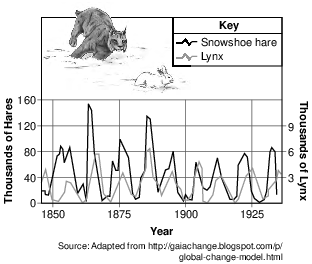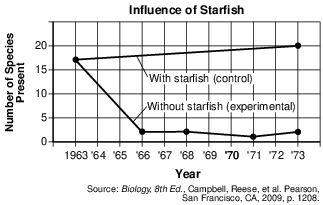Topic: Ls2.D: Social Interactions And Group Behavior
Ls2.D: Social Interactions And Group Behavior
In order for an ecosystem to remain stable there must be
(1) drastic modifications to the environment
(2) interrelationships and interdependencies among organisms
(3) limited biodiversity
(4) gradual changes in the climate
One way humans can promote the survival of organisms in an ecosystem is to
(1) decrease diversity in plant habitats
(2) introduce new consumers to control autotrophs
(3) release extra CO2 into the atmosphere to help autotrophs
(4) learn about the interactions of populations
A fundamental concept of ecology is that living organisms
(1) are independent and do not interact with each other or with the physical environment
(2) do not interact with other living organisms, but do interact with the physical environment
(3) interact with each other, but do not interact with the physical environment
(4) interact with other living organisms and interact with the physical environment
The diagram below shows the relationship between the snowshoe hare and the lynx. The snowshoe hare is prey of the lynx.

The populations of the two species increase and decrease based on the numbers of each species present. This relationship is an example of
(1) ecological succession
(2) an energy pyramid
(3) interdependency
(4) competition
One characteristic of a stable ecosystem is
(1) a high number of predators
(2) an interdependence of organisms
(3) a lack of biodiversity
(4) an increase in human interference
The wetland plant purple loosestrife was imported to North America from Europe. Since its introduction, the loosestrife has spread, which has resulted in a dramatic decline in the biological diversity of native wetland plants. A likely reason for the spread of the purple loosestrife is that it can
(1) successfully compete with native herbivores for food
(2) serve as an excellent food source for native herbivores
(3) successfully compete with native plants for space
(4) prevent the migration of native plants
…Unless actions are taken to slow the decline of domesticated honeybees and augment [increase] their populations with wild bees, many fruits and vegetables may disappear from the food supply, said Claire Kremen, a conservation biologist at Princeton University in New Jersey.…
The honeybee decline, which is affecting domesticated and wild bee populations around the world, is mostly the result of diseases spread as a result of mites and other parasites as well as the spraying of crops with pesticides, scientists say.…
Source: “Bee Declines May Spell End of Some Fruits, Vegetables,” National Geographic News, October 5, 2005
A decrease in honeybee populations will
(1) eliminate the need to spray crops
(2) increase the number of bee parasites
(3) reduce the occurrence of natural disasters
(4) disrupt the stability of an ecosystem
A stable ecosystem can have high biodiversity because each species in that ecosystem
(1) occupies a different niche
(2) inhabits a different environment
(3) is part of a different community
(4) lives in a different biosphere
Stability within an ecosystem is achieved partially by the presence of organisms that break down important molecules and make them available for other organisms to use. These organisms are
(1) plants
(2) herbivores
(3) scavengers
(4) decomposers
A certain species of plant serves as the only food for the young larvae of a particular species of butterfly. In a large field, a disease kills all the members of this plant species. As a result of the plant disease, the butterfly population will most likely
(1) quickly adapt to eat other plants
(2) disappear from the area
(3) evolve to form a new species
(4) enter the adult stage more quickly
In the coastal waters off western North America, there is a starfish species that feeds primarily on mussels, another marine organism. In an experimental area, the starfish were removed from the waters. The effect of this removal is shown in the graph below.

What conclusion can be made regarding the role of the starfish in this ecosystem?
(1) The biodiversity of this ecosystem increased within ten years as organisms adjusted to the loss of the starfish.
(2) The starfish is important in maintaining the biodiversity of this ecosystem.
(3) When the starfish were removed, the ecosystem decreased in stability and increased in biodiversity.
(4) Biodiversity in this ecosystem is not dependent on the presence of starfish.
Since 1980, the vulture population in India has declined from 40 million to 60 thousand due to poisoning by a pain reliever used in cattle. If only 1% of the cattle carcasses fed on by vultures are animals that have been treated with the drug, it can lead to a drastic decline in the vulture population. The grim picture is that over 10% of the carcasses have been found to contain this drug.
Vultures feed exclusively on the carcasses of dead animals. This helps to prevent the spread of diseases such as rabies and anthrax among wildlife, livestock, and humans. Without as many vultures present, other scavengers such as dogs have moved in and taken advantage of the newly available food. The abundance of these other scavengers has led to an increase in the number of cases of human rabies and an outbreak of tuberculosis, anthrax, and foot-and-mouth disease. These diseases are not spread to humans by vultures.
The best explanation for the increase in rabies, anthrax, and other diseases in humans is that the
(1) decrease in the number of vultures has upset ecosystem stability
(2) vulture population is being killed off by an increase in cases of human rabies
(3) vultures are changing their feeding role from scavenger to decomposer
(4) people are consuming scavengers that have eaten diseased vultures
Research has shown that plants might chemically change their environment. The roots of certain plants release many chemicals. Some chemicals made by plants can kill nearby plants or discourage herbivores from eating them. Other plant chemicals kill plant pathogens such as bacteria and fungi.
State two ways that the release of these chemicals is beneficial to these plants. [1]
(1)
(2)
Allow 1 credit for two acceptable responses. Acceptable responses include, but are not limited to:
• — It will keep them from getting a disease.
• — It will keep them from getting eaten.
• — It protects them from pathogens.
• — It will give them a competitive advantage.
• — It keeps other plants from growing nearby.
Coral Reef Ecosystems
There are many ecological interactions that maintain the biodiversity present in coral reefs. In addition to coral, microscopic algae, seaweed, sea grasses, sponges and worms, and a variety of fish are among the organisms that live in reef ecosystems. Ocean currents often link different reef systems and move organisms from one reef area to another. This movement is a factor in repopulating a reef that has been damaged by environmental changes.
One environmental change involves an increased growth of seaweed. When the population of seaweed increases, the reef shifts from a coral-dominated ecosystem to a seaweed-dominated ecosystem. This change disrupts the relationships between the organisms that live there.
Studies have shown that, as the density of seaweed in a reef area increases, the number of fish that eat the seaweed in that area decreases. This may be due to the presence of more predators, or the taste of the more mature plants. The fish move to areas where there is less seaweed growth. As this trend continues, the reef areas are taken over by the seaweed. Once this happens, it is very hard to remove the seaweed and restore the reef to a healthy ecosystem.
In addition to this problem, temperature changes are threatening the ocean currents that connect the reef systems. A change in the currents would reduce the movement of fish larvae from one area to another. This contributes to the seaweed problem.
State one reason why it is important to maintain the stability of the coral reefs. [1]
Allow 1 credit. Acceptable responses include, but are not limited to:
• — in order to maintain the food webs that exist there
• — because many organisms depend on them for food or shelter
• — to maintain biodiversity
• — keep oceans healthy
• — to prevent extinction of reef species
Survey Finds Invasive Snail in St. Lawrence River That Could Threaten Waterfowl
New research has found a larger presence of faucet snails in the Great Lakes than previously recognized, including the northern parts of Lake Ontario and the St. Lawrence River. The invasive species can carry three types of intestinal parasites that can injure and kill waterfowl such as ducks. ...
...When the waterfowl eat the snails, the parasites attack internal organs, causing lesions [sores] and hemorrhage [uncontrolled bleeding]. Birds affected by the snail will fly and dive erratically before their eventual death. The university said that the snails are about 12 to 15 millimeters in height at full size, brown to black with a distinctive whorl of concentric circles on the shell opening cover that looks like tree rings. ...
...Mr. Kosnicki [an ecologist] said the spread of snails, along with other invasive species, shows the need for increased awareness of possible contaminants coming from boats and in runoff from land. ...
Source: Watertown Daily Times, Monday, January 19, 2015, by Gordon Block
Discuss how invasive species can harm an ecosystem. In your answer, be sure to:
• explain one negative effect that faucet snails have on the lake ecosystem [1]
• describe one human activity that can slow the spread of the faucet snail [1]
The student’s response to the bulleted items in the question need not appear in the following order.
• 15 Allow 1 credit for explaining one direct effect that faucet snails have on the lake ecosystem.
• Acceptable responses include, but are not limited to:
• — The faucet snails can infect waterfowl with a parasite that kills the birds.
• — The faucet snails can negatively affect the food web of the lake by causing the loss of the
• waterfowl.
• — The faucet snails kill the ducks.
• 16 Allow 1 credit for describing one human activity that can be taken to slow the spread of the faucet
• snail. Acceptable responses include, but are not limited to:
• — Clean the bottom of a boat when moving it from one body of water to another.
• — Check your boat for snails before putting it in a new lake.
• — Increase awareness of possible contaminants coming from boats.
• — Remove the snails from the lake.
